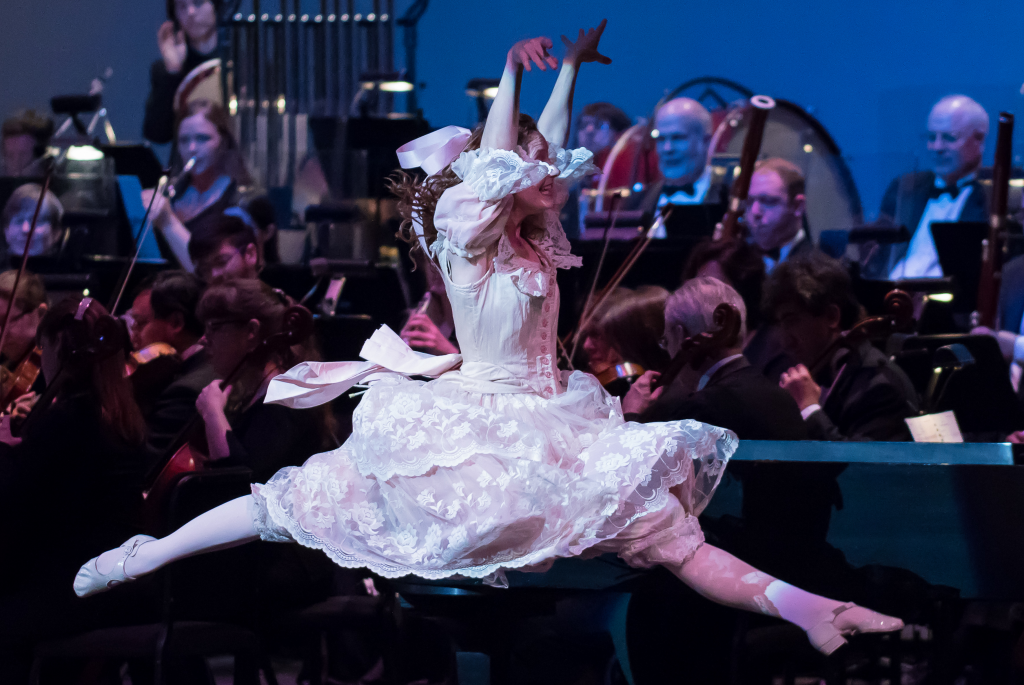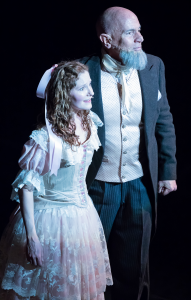“I saw his ship sail into New York Harbor that day in 1891 – past the Statue of Liberty, past the hundreds of people cheering on the shore. All America seemed to be waiting for him and his music…”
Based on the actual historical event, this story tells of the great composer’s arrival in New York for the grand opening of Carnegie Hall in 1891 and his famous trip to Niagara Falls. A surprise encounter with a young American girl, Jennie, reveals much about Tchaikovsky – his life in Russia, his love of music and his fears of conducting. This is a poignant story of the meeting of old world influences and new world experiences; a tale of contrast, courage and classical music.
Audiences will enjoy more than twenty-five excerpts of the composer’s music including passages from his three famous ballets – The Nutcracker, Sleeping Beauty and Swan Lake -The 1812 Overture, First Piano Concerto and String Serenade. The music is magically woven into the drama as two actors recreate historical incidents from the composer’s life and dance story passages from his famous ballets. This delightful concert, dance and story performance is approximately 50 minutes in length and is an ideal addition to any children’s education program or family concert series. This program is recommended for audiences age six and up.
Synopsis

The story begins at New York’s Carnegie Hall and Pyotr Il’yich Tchaikovsky is attending the last orchestral rehearsal before the grand opening. But construction noise makes it impossible to rehearse and Tchaikovsky finds himself on the street hounded by reporters. He escapes on a train to Niagara Falls where he meets Jennie, a young American girl, who dreams of becoming a ballerina. During their train ride they discover much about each other – their joys and fears – and the healing influences they impart.
As Tchaikovsky and Jennie approach Niagara Falls, Tchaikovsky describes what he’s discovered in America, “There’s an electric energy in this country… all these people, so generous and open-hearted… their ideas, their dreams, their music… all flowing together like a mighty river – everything tumbling toward the future!”
“All silent now, the magic spell is told, all silent now, our mystery tale unfolds…”
The original audio recording of Tchaikovsky Discovers America claims dozens of top music, educational, and parenting awards. Based on this highly acclaimed recording, the Tchaikovsky Discovers America theatrical symphony concert is an imaginative way to introduce young audiences and their families to the life and music of Pyotr Il’yich Tchaikovsky in a live performance venue.
Watch & Listen
Audio
Video
Music Excerpts
- Trumpet Fanfare (from Swan Lake)
- Piano Concerto No. 1, Mvmt. I
- Danse Napolitaine (from Swan Lake)
- Trépak (from Nutcracker)
- Waltz (from Serenade in C Major)
- Tea (from Nutcracker)
- Nutcracker, Overture
- Coffee (from Nutcracker)
- Chocolate (from Nutcracker)
- Waltz (from Sleeping Beauty)
- Overture to Act II (from Swan Lake)
- Silver (and Rag) (from Sleeping Beauty)
- Swing Low, Sweet Chariot
- Old Russia (from 1812 Overture)
- Violente (from Sleeping Beauty)
- Piano Concerto No. 1, Mvmt. II
- Marche Slav
- Nutcracker, Act II Coda
- Dance of the Sugar Plum Fairy (from Nutcracker)
- Act II, Entr’acte & Panorama (from Sleeping Beauty)
- Symphony No. 5, Mvmt. II
- La Cygne Noir, Coda (from Swan Lake)
- Amazing Grace (Traditional)
- Serenade in C Major, Mvmt. I
- Serenade in C Major, Mvmt. IV
- 1812 Overture
Instrumentation
 String count 8.8.7.6.5
String count 8.8.7.6.5
3d1.2+1.2+1.2—4.4.2+1.1—3per—tmp—hp—pf+cel—str
The instrumentation listed represents the maximum number of books we will supply to accommodate the largest of orchestras. Though we sill ship our full set of parts, we defer to your judgment in reducing players based on your particular needs and requirements.
A conductor’s score, complete with full score and dialogue cues, musician parts, and a reference script is sent at least 3 weeks in advance of the concert.
Strings
- Violin I (8 stands)
- Violin II (8 stands)
- Viola (7 stands)
- Violoncello (5 stands)
- Contrabass (4 stands)
Woodwinds
- Flute I & II (1 stand each)
- Piccolo/Flute III (1 stand)
- Oboe I & II (1 stand each)
- English Horn (1 stand)
- Clarinet I & II (1 stand each)
- Bass Clarinet (1 stand)
- Bassoon I & II (1 stand)
Brass
- F Horn I, II, III & IV (1 stand each)
- Trumpet I, II, III & IV (1 stand each)
- Trombone I, II & III (1 stand each)
- Tuba (1 stand)
Percussion
- Percussion (3 stands)
- Timpani (1 stand)
- Harp (1 stand)
- Piano/Celeste (1 stand)
This performances assumes a seamless performance, largely unbroken by applause or “soloist” appearances. It requires a large Tchaikovsky orchestra, necessary for the ending of the 1812 Overture and Swan Lake Overture to Act II.
Note that a pianist is necessary for the following:
Piano Concerto No. 1, Mvmt. I (first statement only)
Piano Concerto No. 1, Mvmt. II (approximately 24 bars)
A short Ragtime on Silver (and Rag) from Sleeping Beauty
Some short piano waltzes and spirituals
The pianist may also double on the Celeste.
The pieces included in this performance are well studied by most musicians. Orchestras who have not performed the Nutcracker, Swan Lake, Sleeping Beauty, Piano Concerto No. 1, Serenade for Stings, Symphony No. 5, and 1812 Overture (Finale) are encouraged to hold rehearsals on their own in advance of the scheduled rehearsal.
